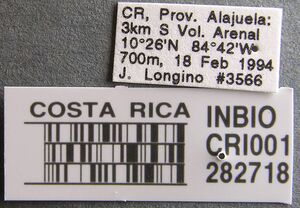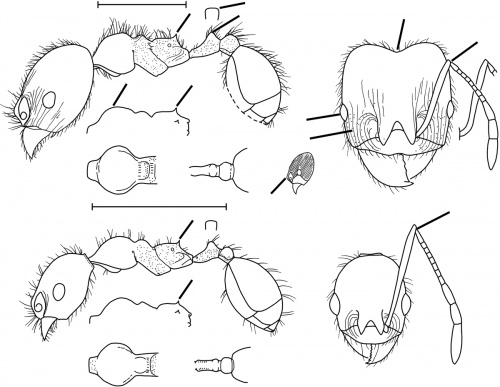Pheidole vafra
| Pheidole vafra | |
|---|---|

| |
| Scientific classification | |
| Kingdom: | Animalia |
| Phylum: | Arthropoda |
| Class: | Insecta |
| Order: | Hymenoptera |
| Family: | Formicidae |
| Subfamily: | Myrmicinae |
| Tribe: | Attini |
| Genus: | Pheidole |
| Species group: | diligens |
| Species: | P. vafra |
| Binomial name | |
| Pheidole vafra Santschi, 1923 | |
This appears to be a widespread weedy species (Longino, 2019). The very wide distribution suggests that vafra may be carried by human commerce. In any case, it inhabits marginal habitats. I found nests common in sandy soil at two localities along the southern coast of Tobago, where it coexists with the very widespread marginal-habitat specialist Pheidole jelskii. Near the Nariva Swamp of Trinidad, Stefan Cover found a colony at the border between a coconut grove and mangrove swamp, nesting under a fallen coconut leaf in sand; and a second colony at 550 m in Trinidad’s Arima Valley, nesting in the hard-packed clay of a road running through a small coffee plantation. (Wilson 2003)
Identification
See the description in the nomenclature section.
Keys including this Species
Distribution
This hitherto obscure species turns out to be one of the most widespread of all New World Pheidole. (Wilson 2003)
Latitudinal Distribution Pattern
Latitudinal Range: 13.33333333° to -31.657°.
| North Temperate |
North Subtropical |
Tropical | South Subtropical |
South Temperate |
- Source: AntMaps
Distribution based on Regional Taxon Lists
Neotropical Region: Argentina, Brazil (type locality), Colombia, Costa Rica, French Guiana, Nicaragua, Panama, Paraguay, Trinidad and Tobago, Venezuela.
Distribution based on AntMaps
Distribution based on AntWeb specimens
Check data from AntWeb
Countries Occupied
| Number of countries occupied by this species based on AntWiki Regional Taxon Lists. In general, fewer countries occupied indicates a narrower range, while more countries indicates a more widespread species. |

|
Estimated Abundance
| Relative abundance based on number of AntMaps records per species (this species within the purple bar). Fewer records (to the left) indicates a less abundant/encountered species while more records (to the right) indicates more abundant/encountered species. |

|
Biology
Castes
Worker
Minor
Images from AntWeb
   
| |
| Worker. Specimen code casent0178064. Photographer April Nobile, uploaded by California Academy of Sciences. | Owned by ALWC, Alex L. Wild Collection. |
  
| |
| Worker. Specimen code casent0635482. Photographer J. Longino, uploaded by University of Utah. | Owned by JTLC. |
Major
Images from AntWeb
  
| |
| Worker (major/soldier). Specimen code inbiocri001282718. Photographer J. Longino, uploaded by University of Utah. | Owned by JTLC. |
Nomenclature
The following information is derived from Barry Bolton's Online Catalogue of the Ants of the World.
- vafra. Pheidole vafra Santschi, 1923d: 51 (s.w.) BRAZIL.
- Status as species: Casadei-Ferreira, Economo & Feitosa, 2020: 4.
Taxonomic Notes
The images of the types of P. vafra match the types of Wilson's P. laticornis.
Unless otherwise noted the text for the remainder of this section is reported from the publication that includes the original description.
Description
From Wilson (2003): A small, brown member of the diligens group, whose major has a faintly bicolorous head; smooth anterior third of the head dorsal surface; abundant medium-length pilosity; relatively short antennal scapes, which are curved near their base; and equilaterally triangular postpetiolar spine in side view.
Close to Pheidole blumenauensis, Pheidole perryorum and Pheidole rochai, but major differing in its shorter scapes, eyes larger than in rochai (but not in blumenauensis) and other details of body form and sculpturing in both major and minor, as illustrated.
See also less similar Pheidole laevifrons, Pheidole lemur, Pheidole peregrina, Pheidole pubiventris and Pheidole seeldrayersi.
MEASUREMENTS (mm) Lectotype major: HW 0.96, HL 1.04, SL 0.74, EL 0.20, PW 0.54. Paralectotype minor: HW 0.52, HL 0.64, SL 0.74, EL 0.14, PW 0.36.
COLOR Major: gaster medium brown, rest of body light brown except for anterior one-fourth of head capsule, which is a slightly contrasting brownish yellow.
Minor: concolorous medium brown.
Pheidole vafra
A member of the diligens group close to Pheidole coffeicola and Pheidole vafra and differing from that species and other diligens group members by the following combination of traits.
Major: scape broadened at the base, wider there than near the apex; head dark yellow, with brown spot on vertex; propodeal spines reduced to denticles.
Minor: propodeal spines reduced to denticles; occiput narrowed, with nuchal collar. Other traits as illustrated.
MEASUREMENTS (mm) Holotype major: HW 1.02, HL 1.08, SL 0.76, EL 0.18, PW 0.58. Paratype minor: HW 0.48, HL 0.60, SL 0.76, EL 0.14, PW 0.34.
COLOR Major: body and head dark yellow, with fuzzy, circular brown spot on vertex, except for gaster, which is yellowish brown.
Minor: mesosoma, petiole, and appendages dark yellow; head, postpetiole, and gaster yellowish to plain light brown.
Pheidole idiota. Upper: lectotype, major. BRAZIL: Blumenau, Santa Catarina. (Outer antennal scape is from near Nariva Swamp, Trinidad.) Lower: minor. TRINIDAD: near Nariva Swamp (compared with paralectotype minor). Scale bars = 1 mm.
Figure. Upper: holotype, major. Lower: paratype, minor. Scale bars = 1 mm.
Type Material
Pheidole idiota: BRAZIL: Blumenau, Santa Catarina. Naturhistorisches Museum, Basel - as reported in Wilson (2003)
Pheidole vafra: COSTA RICA: Palmar, Puntarenas, col. E. O. Wilson. Museum of Comparative Zoology
Etymology
Pheidole idiota: L vafra, artful, craftful, allusion unknown. (Wilson 2003)
Pheidole vafra: L laticornis, broad-horned, referring to the basally widened scape.
References
- Wilson, E. O. 2003. Pheidole in the New World: A dominant, hyperdiverse ant genus. Harvard University Press, Cambridge, MA. (page 244, Senior synonym of idiota, fig. major, minor described)
- Casadei-Ferreira, A., Economo, E.P., Feitosa, R.M. 2020. Additions to the taxonomy of Pheidole (Hymenoptera: Formicidae) from the southern grasslands of Brazil. Revista Brasileira de Entomologia 64(4):e20200068 (doi:10.1590/1806-9665-RBENT-2020-0068).
- Franco, W., Ladino, N., Delabie, J.H.C., Dejean, A., Orivel, J., Fichaux, M., Groc, S., Leponce, M., Feitosa, R.M. 2019. First checklist of the ants (Hymenoptera: Formicidae) of French Guiana. Zootaxa 4674, 509–543 (doi:10.11646/zootaxa.4674.5.2).
- Santschi, F. 1923d. Pheidole et quelques autres fourmis néotropiques. Ann. Soc. Entomol. Belg. 63: 45-69 (page 51, soldier, worker described)
References based on Global Ant Biodiversity Informatics
- Fernández, F. and S. Sendoya. 2004. Lista de las hormigas neotropicales. Biota Colombiana Volume 5, Number 1.
- Franco W., N. Ladino, J. H. C. Delabie, A. Dejean, J. Orivel, M. Fichaux, S. Groc, M. Leponce, and R. M. Feitosa. 2019. First checklist of the ants (Hymenoptera: Formicidae) of French Guiana. Zootaxa 4674(5): 509-543.
- Kempf, W.W. 1972. Catalago abreviado das formigas da regiao Neotropical (Hym. Formicidae) Studia Entomologica 15(1-4).
- Kusnezov N. 1952. El género Pheidole en la Argentina (Hymenoptera, Formicidae). Acta Zoologica Lilloana 12: 5-88.
- Kusnezov N. 1956. Claves para la identificación de las hormigas de la fauna argentina. Idia 104-105: 1-56.
- Longino J. T. 2019. Pheidole (Hymenoptera, Formicidae) of Middle American wet forest. Zootaxa 4599: 1-126
- Rosa da Silva R. 1999. Formigas (Hymenoptera: Formicidae) do oeste de Santa Catarina: historico das coletas e lista atualizada das especies do Estado de Santa Catarina. Biotemas 12(2): 75-100.
- Santschi F. 1923. Pheidole et quelques autres fourmis néotropiques. Annales de la Société Entomologique de Belgique 63: 45-69.
- Santschi F. 1929. Nouvelles fourmis de la République Argentine et du Brésil. Anales de la Sociedad Cientifica Argentina. 107: 273-316.
- Wild, A. L. "A catalogue of the ants of Paraguay (Hymenoptera: Formicidae)." Zootaxa 1622 (2007): 1-55.
- Wilson, E.O. 2003. Pheidole in the New World: A Dominant, Hyperdiverse Genus. Harvard University Press
- da Silva de Oliveira A. B., and F. A. Schmidt. 2019. Ant assemblages of Brazil nut trees Bertholletia excelsa in forest and pasture habitats in the Southwestern Brazilian Amazon. Biodiversity and Conservation 28(2): 329-344.



